Student discipline procedure
Audience
All state schools
Purpose
This procedure sets out the responsibilities and processes to promote safe, supportive and disciplined learning environments in Queensland state schools. It supports schools to understand and meet their legislative obligations, to maintain good order and management of schools and provide access to state education to ensure all students can participate in and gain positive outcomes from schooling.
Overview
This procedure includes:
- the requirement for all state schools to have a Student Code of Conduct
- clear expectations about staff responsibilities to support students to understand and meet discipline expectations of the school
- guidance on the application, where required, of disciplinary consequences.
This procedure is based on the legislative framework outlined in Chapter 12, Education (General Provisions) Act 2006 (Qld).
Responsibilities
Director-General (or delegate)
- make decisions about excluding a student from a state school, certain state schools, or all Queensland state schools
- respond to submissions against Director-General (or delegate) decisions relating to suspension or exclusion
- respond to submissions made against a principal’s decision to:
- suspend a student for 11-20 days
- suspend a student on a charge-related ground
- exclude a student
- respond to periodic review submissions related to permanent exclusion
- exercise the suspension or exclusion power of the Principal if the Principal of a state school or the Director-General (or delegate) reasonably believes it would be appropriate for the Director-General (or delegate) to exercise the power
- ensure decisions are compatible with the
Human Rights Act 2019 (Qld).
The Director-General may delegate decisions. If so, the delegate may exercise the Director-General’s power.
Principals
- ensure compliance with the procedure determined by the Director-General (or delegate)
- develop a Student Code of Conduct in consultation with the school community, including employees, which is consistent with the expectations outlined in this procedure
- implement a communication plan to ensure all staff, students and the wider school community are aware of the content and can access the Student Code of Conduct
- make school disciplinary absence decisions
- understand that decisions about school disciplinary absences cannot be delegated to other staff
- use the Instrument of Authorisation to record any authorisation/s given by the Principal for the Deputy Principal, Head of School and/or Head of Campus to tell students and parents of suspension or exclusion decisions made by the Principal
- refer school disciplinary absence decisions to the Director-General (or delegate) where it is inappropriate for the Principal to make the decision (e.g. due to bias)
- assess risks regarding disciplinary consequences
- take into account a student’s individual circumstances, such as behaviour history, disability, mental health and wellbeing, religious and cultural considerations, home environment and care arrangements when responding to inappropriate behaviour and applying any disciplinary consequence
- take reasonable steps to arrange for the student to continue to access their educational program for the duration of their school disciplinary absence
- ensure school disciplinary absence decisions are compatible with the
Human Rights Act 2019 (Qld)
- are mindful of their obligations under the
Disability Standards for Education 2005 (Cwth)
- ensure school disciplinary absence decisions are documented in OneSchool
- ensure signed copies of all letters (also known as approved forms) and attachments relating to school disciplinary absence decisions are uploaded into OneSchool.
Teachers
- familiarise themselves with the school’s Student Code of Conduct, including support and response strategies for students
- implement expectations consistent with the school’s Student Code of Conduct
- explicitly teach student’s expected behaviours and provide opportunities for them to practise the expected behaviours
- provide differentiated teaching to respond to the particular learning needs of all students as a regular part of classroom instructional practice
- take into account a student’s individual circumstances, such as the student’s behaviour history, disability, mental health and wellbeing, religious and cultural considerations, home environment and care arrangements when responding to inappropriate student behaviour
- document disciplinary incidents in OneSchool in a timely manner (within school day).
Regional Case Managers
Regional Case Managers are any allocated officer that the Regional Director or delegate deems is appropriately qualified to undertake this role. These staff:
- act as a point of contact for the student and their family when student is subject to a charge-related suspension, suspension pending exclusion or exclusion
- support the Principal of the student’s school to take reasonable steps to arrange for the student to continue to access their educational program for the duration of their school disciplinary absence
- record contact with student and family in OneSchool, including copies of correspondence
- provide assistance with understanding disciplinary consequences and appeal processes, including making arrangements to support submission of oral appeals
- take into account a student’s individual circumstances, such as the student’s behaviour history, disability, mental health and wellbeing, religious and cultural considerations, home environment and care arrangements.
Process
Student Code of Conduct
Principals
- consult the school community, including employees, to develop a Student Code of Conduct which outlines expected behaviour in the school
- ensure the Student Code of Conduct provides information about:
- explicit teaching of expected behaviours and opportunities for students to practise appropriate responses
- differentiated teaching to respond to the particular learning needs of all students as a practice feature of the teaching approach across the school
- how to take into account a student’s individual circumstances, such as the student’s behaviour history, disability, mental health and wellbeing, religious and cultural considerations, home environment and care arrangements when responding to inappropriate behaviour
- confidentiality obligations limiting discussion or sharing information about individual circumstances of students, including applied disciplinary consequences, with persons other than the student’s parent/s
- ensure a signed copy of the Student Code of Conduct is publicly available on the school website, reviewed and updated annually to maintain currency and comprehensively reviewed every four years in line with cycles of the School Strategic Plan (DoE employees only).
Disciplinary consequences – General principles
Principal or Director-General (or delegate)
Prior to making a decision about disciplinary consequences, including detention, removal of privileges, suspension or exclusion:
- assess the student’s behaviour and the level of risk the behaviour presents
- undertake an assessment of the human rights that may be impacted by any decision and consider whether the limit placed on those human rights is reasonable and justified. The assessment must be documented appropriately
- take into account:
- a student’s individual circumstances, such as behaviour history, disability, mental health and wellbeing, religious and cultural considerations, home environment and care arrangements
- procedural fairness in all decision making
- that the grounds for suspending or excluding a student apply to all students, including mature aged students
- the conduct of a student may include an omission to perform an act by the student
- that action can be taken to address behaviour occurring outside school premises or school hours
- that an offence includes an act or omission committed outside of Queensland that would be an offence if it were committed in Queensland
- apply a school disciplinary absence, such suspension or exclusion, as a strategy of last resort.
Suspensions (1-10 or 11-20 days)
Principals
- are the only staff members under the
Education (General Provisions) Act 2006 (Qld) with the power to make a decision about the use of suspension for an enrolled student
- in contemplating the use of suspension as a disciplinary consequence, consider whether the student’s behaviour constitutes one or more of the following grounds from section.282 of the Education (General Provisions) Act 2006 (Qld):
- disobedience
- misbehaviour
- conduct that adversely affects, or is likely to adversely affect, other students (may be ground for suspension even if the conduct does not happen on school premises or during school hours)
- conduct that adversely affects, or is likely to adversely affect, the good order and management of the school (may be ground for suspension even if the conduct does not happen on school premises or during school hours)
- the student’s attendance at the school poses an unacceptable risk to the safety or wellbeing of other students or staff
- the student is charged with a serious offence (refer to Flowchart: Suspension (charge-related))
- the student is charged with an offence other than a serious offence and the Principal is reasonably satisfied it would not be in the best interests of other students or of staff for the student to attend the school while the charge is pending (refer to Flowchart: Suspension (charge-related))
- provide the student and parent written notice of the suspension on the approved form
- may authorise a Deputy Principal, Head of School or Head of Campus to tell a student and parent of the Principal’s decision to suspend.
Flowchart: Suspensions (1-10 days)
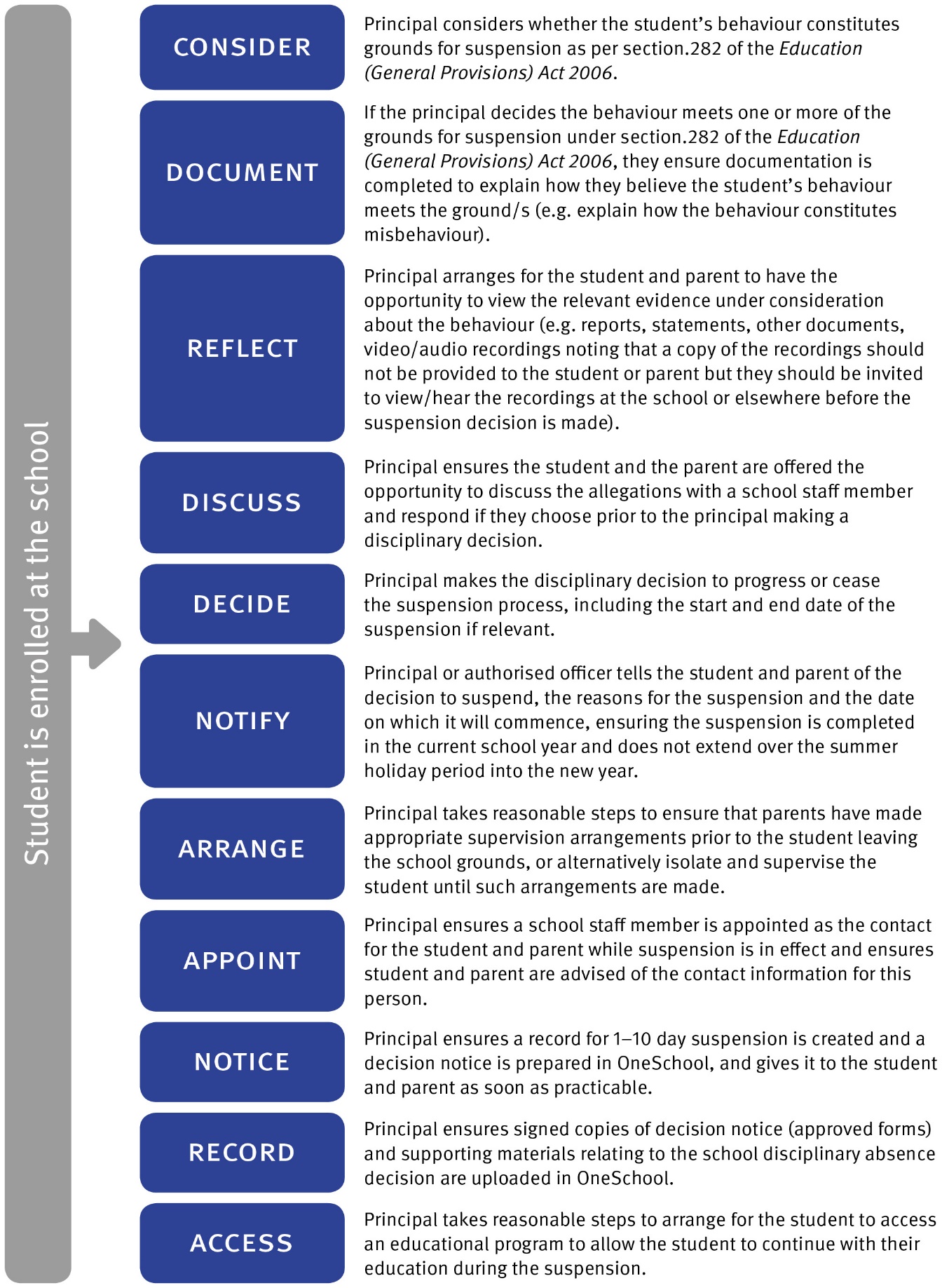
Flowchart: Suspensions (11-20 days)
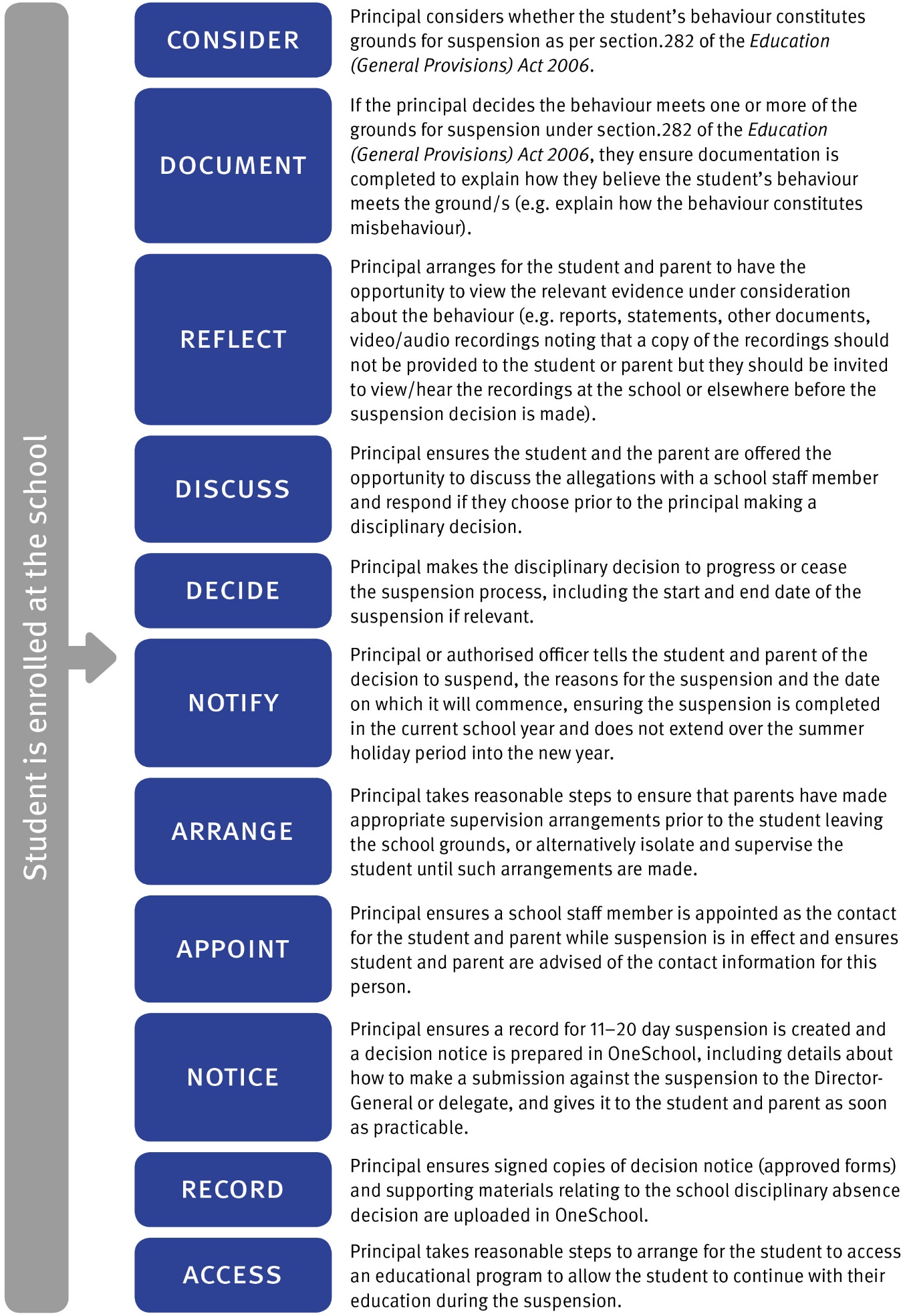
Flowchart: Suspensions (charge-related)
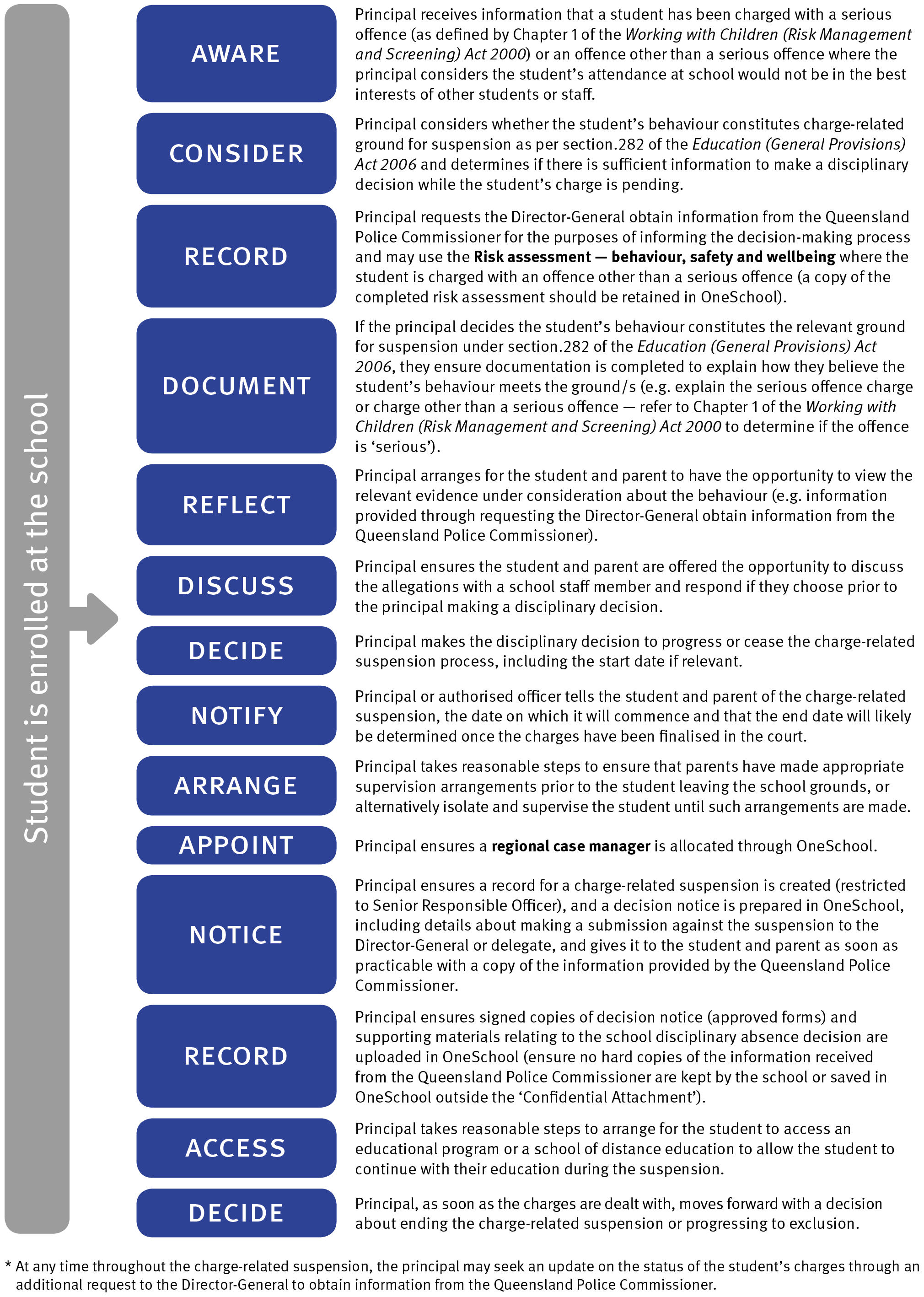
Exclusion by Principals
Principals
- are the only persons authorised under the Education (General Provisions) Act 2006 (Qld) to make a disciplinary decision about the use of exclusion
- consider exclusion only as a last resort, including if suspension is demonstrably inadequate to deal with the student’s disobedience, misbehaviour, conduct or risk (e.g. student has sold a large quantity of illicit drugs, seriously assaulted a staff member)
- in contemplating disciplinary consequences, consider whether the suspension of the student under division 2 of the Education (General Provisions) Act
2006 (Qld) is inadequate to deal with the disobedience, misbehaviour, conduct or risk, and if so, whether the student’s behaviour constitutes one or more of the following grounds under section.292 of the Education (General Provisions) Act 2006 (Qld):
- persistent disobedience
- misbehaviour
- conduct that adversely affects, or is likely to adversely affect, other students (may be ground for exclusion even if the conduct does not happen on school premises or during school hours)
- conduct that adversely affects, or is likely to adversely affect, the good order and management of the school (may be ground for exclusion even if the conduct does not happen on school premises or during school hours)
- the student’s attendance at the school poses an unacceptable risk to the safety or wellbeing of other students or staff
- It is also ground for exclusion if:
- the student has been convicted of an offence and the Principal is reasonably satisfied it would not be in the best interests of other students or staff for the student to continue to be enrolled at the school
- provide the student and parent written notice of the proposed exclusion on the approved form
- ensure the student and parent have at least five school days of receiving the proposed exclusion notice to provide relevant additional information or responses to allegations prior to making a final decision
- finalise the decision within 20 school days of providing the student and parent with the proposed exclusion notice
- provide the student and parent written notice of the exclusion decision on the approved form
- may authorise a Deputy Principal, Head of School or Head of Campus to tell a student and parent of the Principal’s decision to exclude.
Flowchart: Exclusion by Principals
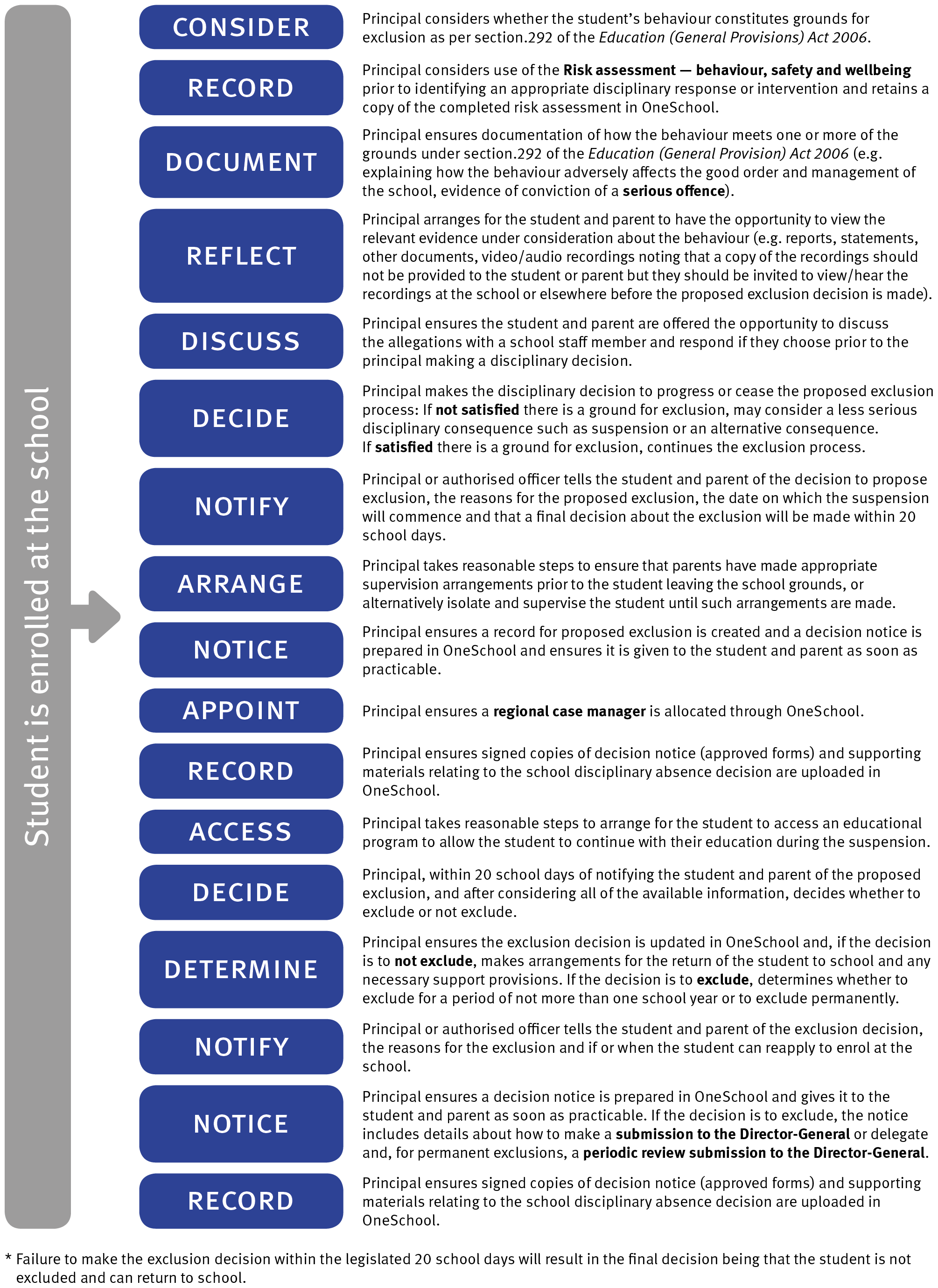
Exclusion by Director-General (or delegate) – certain Queensland state schools or all state schools
Principals
- consider exclusion from the school only as a last resort, including if suspension is demonstrably inadequate to deal with the student’s disobedience, misbehaviour, conduct or risk (e.g. student has sold a large quantity of illicit drugs, seriously assaulted a staff member)
- consider whether suspension of the student under division 2 of the Education (General Provisions) Act 2006 (Qld) is inadequate to deal with the disobedience, misbehaviour, conduct or risk, and if so, whether the student’s behaviour constitutes one or more of the following grounds under section.292 of the Education (General Provisions) Act 2006 (Qld):
- persistent disobedience
- misbehaviour
- conduct that adversely affects, or is likely to adversely affect, other students (may be ground for exclusion even if the conduct does not happen on school premises or during school hours)
- conduct that adversely affects, or is likely to adversely affect, the good order and management of the school (may be ground for exclusion even if the conduct does not happen on school premises or during school hours)
- the student’s attendance at the school poses an unacceptable risk to the safety or wellbeing of other students or staff
- It is also ground for exclusion if:
- the student has been convicted of an offence and the Principal is reasonably satisfied it would not be in the best interests of other students or staff for the student to continue to be enrolled at the school
- consider whether exclusion of the student under Part 12, Division 3 of the Education (General Provisions) Act 2006 (Qld) is inadequate to deal with the disobedience, misbehaviour, conduct or risk, or the student poses an unacceptable risk to the safety or wellbeing of certain or all state school communities
- complete an SD-1 Principal referral at the same time as the written notice of the proposed exclusion
- provide the student and parent with written notice of the proposed exclusion from the school on the approved form, including a copy of the SD-1 Principal referral
- forward the SD-1 Principal referral to the Regional Director and the written notice of the proposed exclusion with any relevant decision-making documentation (e.g. Behaviour Risk Assessment, OneSchool records) within five school days
- ensure the student and parent have at least five school days of receiving the proposed exclusion notice to provide relevant additional information or responses to allegations prior to making a final decision
- finalise the decision within 20 school days of providing the student and parent with the proposed exclusion notice
- provide the student and parent written notice of the exclusion decision on the approved form
- may authorise a Deputy Principal, Head of School or Head of Campus to tell a student and parent of the Principal’s decision to exclude
- respond to any request from the Director-General (or delegate) for information.
Regional Directors
Director-General (or delegate)
- upon receipt, considers the SD-1 Principal referral, SD-2 Regional Director referral and any relevant decision-making documentation (e.g. Behaviour Risk Assessment, OneSchool records)
- considers whether they believe the student poses an unacceptable risk to the safety or wellbeing of certain or all state schools, and if exclusion by the principal under section.292 of the Education (General Provisions) Act 2006 (Qld) is inadequate to deal with the student’s behaviour
- arranges for the student and parent/s to be verbally notified of the proposed exclusion from certain or all state schools
- ensures a decision notice of the proposed exclusion from certain or all state schools is provided to the student and family and signed copies are saved in OneSchool
- finalises the decision within 30 school days of providing the student and parent with the proposed exclusion notice and after considering any relevant decision-making documentation
- records their decision on SD-3 Director-General Exclusion decision notice and ensures copies of signed documents are saved in OneSchool
- arranges for the student and parent/s to be verbally notified of the exclusion from certain or all state schools decision
- sends written notice of the exclusion decision to student, parent/s, Regional Director and Principal.
Flowchart: Exclusion by Director-General (or delegate) - certain Queensland state schools or all state schools
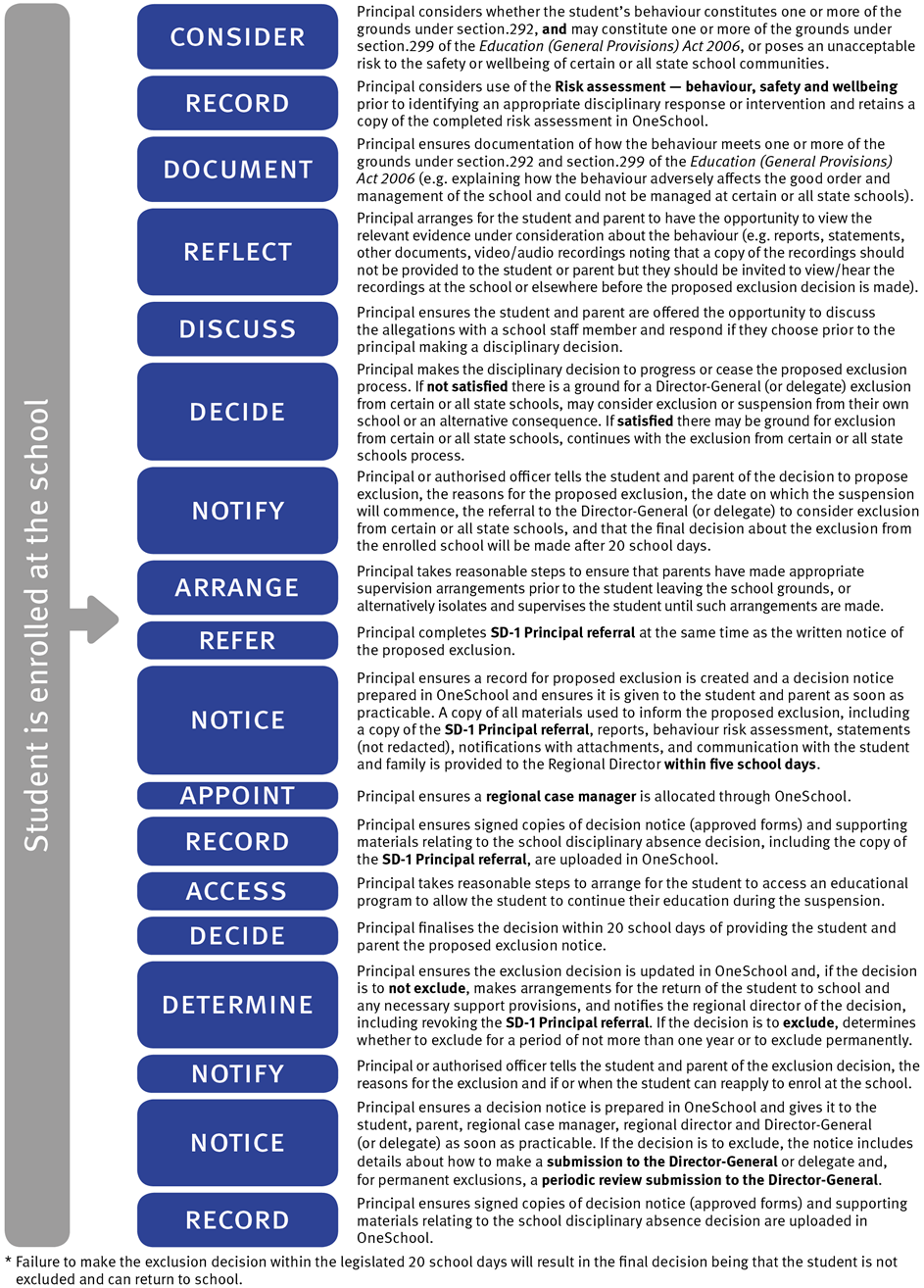
Flowchart:
Exclusion by Director-General (or delegate) - certain Queensland state schools or all state schools continued
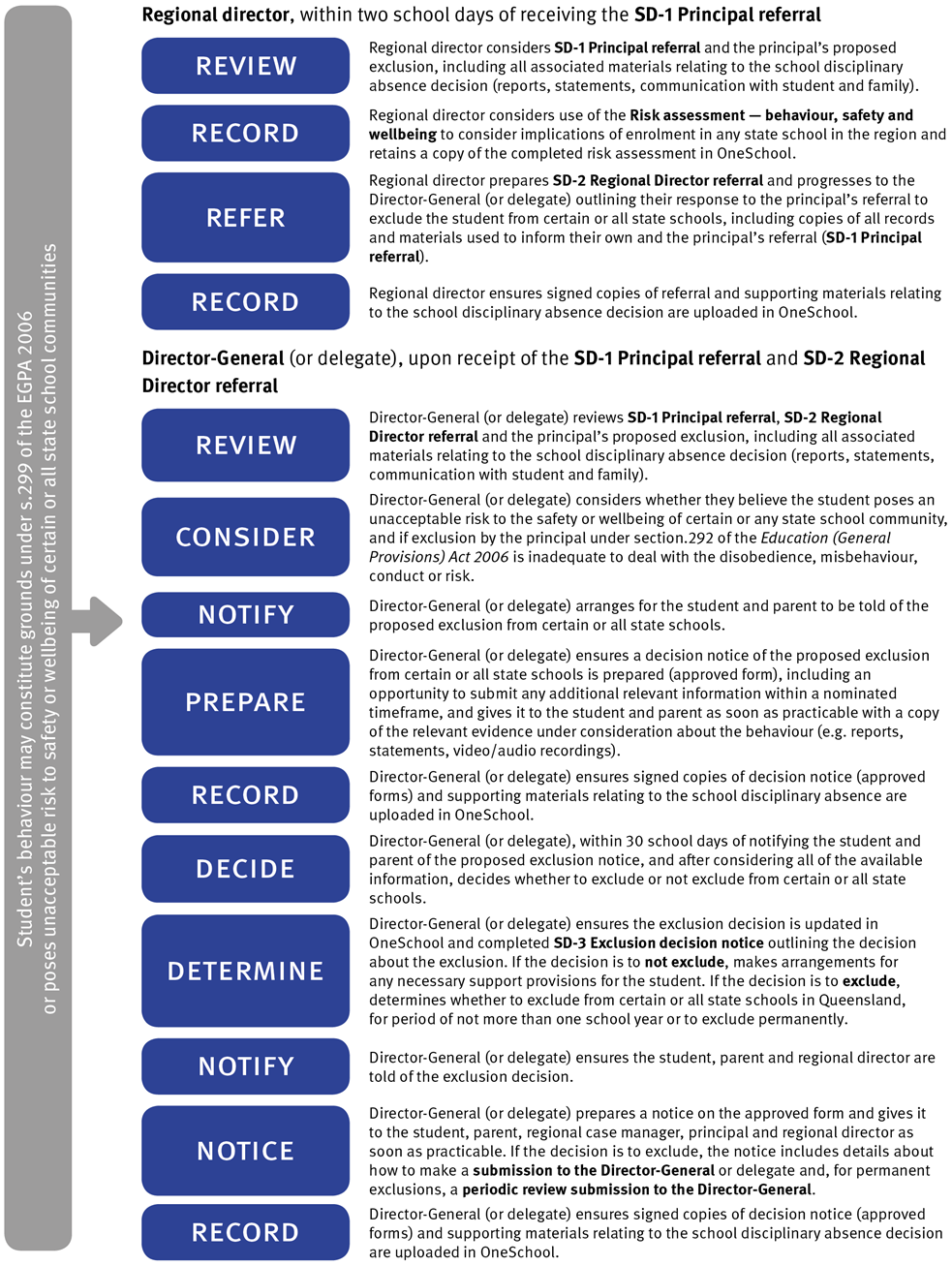
Submission against an 11-20 day suspension or charge-related suspension
Parent or student
- prepares a written submission against the suspension decision within five school days of being notified in writing of the suspension decision
- sends submission to the Director-General (or delegate).
Principal
- responds to requests for information from the Director-General (or delegate) in a timely manner.
Director-General (or delegate)
- gathers any information required to address the points raised in the submission and provides de-identified copies of any relevant new materials that were considered to the student and/or parent to allow them to consider the new materials (e.g. a Principal’s Report) and to provide a response as soon as practicable
- following consideration of the submission and any other relevant information provided by the student, parent and school, confirms, varies, or sets aside the decision to suspend the student
- verbally notifies the student and/or parent and Principal of the decision as soon as practicable
- creates a notice on the approved form of the decision and sends to the student, parent and Principal as soon as practicable
- uploads signed copies of the decision notice and supporting materials into the student’s OneSchool record.
Submission against an exclusion
Parent or student
- prepares a written submission against the exclusion decision within 30 school days of being notified in writing of the exclusion decision
- sends submission to the Director-General (or delegate).
Principal
- responds to requests for information from the Director-General (or delegate) in a timely manner.
Director-General (or delegate)
- gathers any information required to address the points raised in the submission and provides de-identified copies of any relevant new materials that were considered to the student and/or parent to allow them to consider the new materials (e.g. a Principal’s Report) and to provide a response as soon as practicable
- within 40 school days after receipt of any submission, and following consideration of the submission and any other relevant information provided by the student, parent and school, confirms, amends, or sets aside the decision to exclude the student from certain or all state schools
- verbally notifies the student and/or parent, Principal and Regional Case Manager of the decision as soon as practicable
- creates a notice on the approved form of the decision and gives it to the student, parent, Principal and Regional Case Manager as soon as practicable
- uploads signed copies of the decision notice and supporting materials into the student’s OneSchool record.
Periodic review of submission against permanent exclusion
Parent (or student)
- until the student is 24 years of age, a request for a periodic review of the exclusion decision is entitled to be made each calendar year. These submissions may commence in the calendar year after being notified of the permanent exclusion decision. For example, a student whose permanent exclusion decision is finalised on 24 October 2019 is entitled to make a submission from 1 January 2020
- sends submission to the Principal who made the exclusion decision or the Director-General (or delegate).
Principal or Director-General (or delegate)
- gathers any information required to address the points raised in the submission and provide de-identified copies of any relevant new materials that were considered to the student and/or parent to allow them to consider the new materials (e.g. a Principal’s Report) and to provide a response as soon as practicable
- within 40 school days after receipt of any submission, and following consideration of the submission and any relevant information provided by the student, parent and school, makes a decision to either
- revoke the decision: if the disobedience, misbehaviour or other conduct is unlikely to recur if the student was allowed to attend the school or schools; if the student’s attendance at the school or schools no longer poses an unacceptable risk to the safety or wellbeing of other students or staff; or it would no longer not be in the best interests of other students or of staff for the student to be enrolled in the school or schools
- not revoke the decision to exclude the student
- verbally notify the student and/or parent, Principal and Regional Case Manager of the decision as soon as practicable
- create a written notice on the approved form of the decision and send to the student, parent, Principal and Regional Case Manager as soon as practicable
- upload signed copies of the decision notice and supporting materials into the student’s OneSchool record.
Definitions
|
Term
|
Definition
|
|
Appropriately authorised
|
Deputy Principal, Head of School or Head of Campus who has been authorised to communicate the decision about school disciplinary absences on behalf of the Principal. The Instrument of Authorisation is used to record this authorisation.
|
|
Approved form
|
An approved form for a school disciplinary absence is the departmental proforma located in OneSchool.
|
|
Charge-related ground
|
As outlined in section.282 of the
Education (General Provisions) Act 2006 (Qld) (EGPA), a charge-related ground is where the student is either charged with a serious offence or the student is charged with an offence other than a serious offence and the Principal is reasonably satisfied it would not be in the best interests of other students or of staff for the student to attend the school while the charge is pending.
|
|
Conduct
|
Conduct refers to the behaviour of a student specifically described in section.282(c)(d) and section.292(c)(d) of the
Education (General Provisions) Act 2006 (Qld). Conduct of a student also includes that which does not happen on school premises, or during school hours. Conduct of a student includes an omission to perform an act by the student.
|
|
Disciplinary consequences and decisions
|
Disciplinary consequences and decisions may include suspension or exclusion of a student. They can also include other strategies such as detention, discipline improvement plans, etc.
Detentions, discipline improvement plans, drug and alcohol education programs and other disciplinary consequences are optional strategies that can be implemented by a Principal. The range of possible disciplinary consequences should be discussed with the community during the consultation phase of the Student Code of Conduct.
|
|
Dealt with
|
Dealt with in relation to a charge against a student for an offence means any of the following:
- the student is acquitted or convicted of the charge
- the student is convicted of another offence arising out of substantially the same acts or omissions as those constituting the charge
- the charge is withdrawn or dismissed or a nolle prosequi (a prosecutor’s decision to voluntarily discontinue criminal charges either before trial or before a verdict is rendered) or no true bill (the prosecution decides not to present an indictment against an accused person after the accused person has been committed by a Magistrates Court to stand trial in a superior court, thereby ending the prosecution) is presented in relation to the charge.
|
|
Last resort
|
Means that staff have implemented all evidence based positive and proactive approaches for reducing behavioural risk and they have not reduced that risk or the risk is increasing due to behavioural escalation. Last resort responses of suspension or exclusion are a final course of action when no other alternative is available and likely to reduce risk.
|
|
Oral appeals
|
An independent person may be employed by the department to transcribe the oral appeal of a parent or student. This is a transcription provision only, not intended to prepare or guide the content of the appeal. The submission of the appeal remains the responsibility of the parent or student.
|
|
Parent
|
A child’s mother, a child’s father, a person who exercises parental responsibility and a person standing in the place of a parent of a child on a temporary basis. This may include the Office of the Public Guardian or a Child Safety Officer.
|
|
Procedural fairness
|
Procedural fairness comprises two elements:
- the right to be told the allegations against you, a reasonable opportunity to see and consider the evidence relied upon by the decision maker, and a reasonable opportunity to present your case and be given a fair hearing before the decision is made;
- the right to have a decision made by an unbiased decision maker.
|
|
Serious offence
|
A serious offence as defined by Chapter 1 of the
Working with Children (Risk Management and Screening) Act 2000 (Qld)
|
Legislation
Delegations/Authorisations
Other resources
Superseded versions
Previous seven years shown. Minor version updates not included.
7.0 Safe, supportive and disciplined school environment
1.0 Student discipline procedure